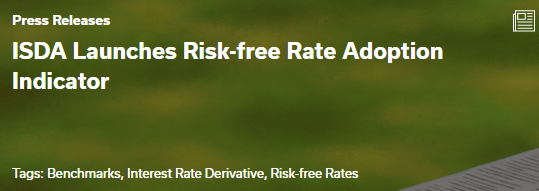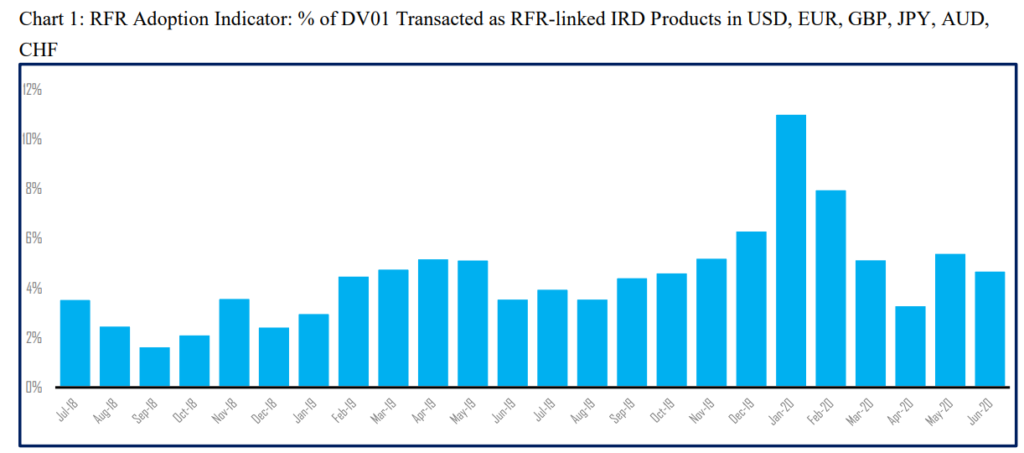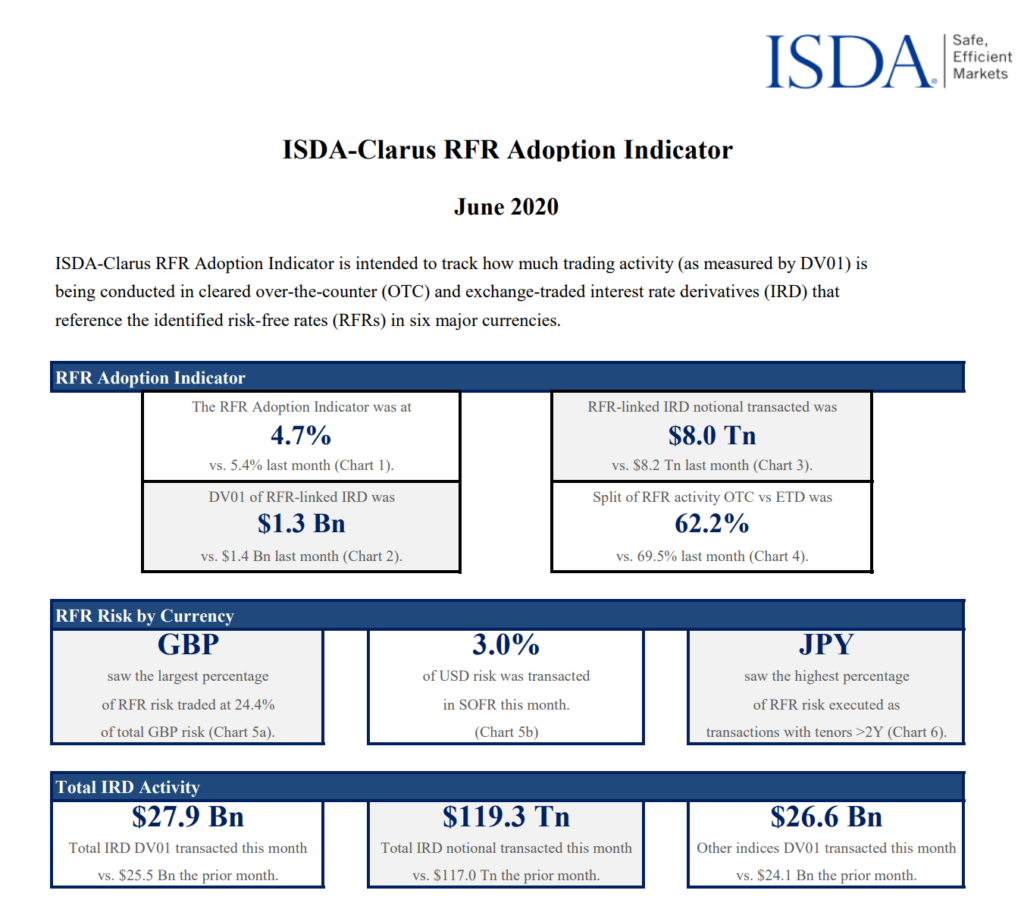- The ISDA-Clarus RFR Adoption Indicator was at 4.7% in June 2020.
- This indicator measures the risk-weighted (DV01) percentage of trading activity that takes place in RFR products.
- Five further sub-indicators have been developed in conjunction with ISDA, providing market participants with granular transparency into RFR activity.
- Check out the first publication to learn about RFR activity in SOFR, SONIA, €STR, TONA, SARON and AONIA.
Introducing the ISDA-Clarus RFR Adoption Indicator
ISDA has launched a new indicator to monitor the adoption of alternative risk-free rates (RFRs) in derivatives trading.
The indicator was developed in conjunction with Clarus, using derivatives volume data from CCPView. It has been built using Clarus Microservices.
The indicator calculates the risk-weighted percentage of trading activity that takes place in RFR derivatives products each month.
You can read the ISDA press release here, check out the first monthly report here and discover the whitepaper with the detailed methodology here.
 +
+ = Safe, Efficient, Transparent Markets
= Safe, Efficient, Transparent Markets
It has been a great experience working alongside ISDA to develop and bring to market this important tool for IBOR transition.
Very simply, our goal is to show how much new trading activity per month is taking place against Risk Free Rates in derivatives markets.
Historically, up to 11% of trading activity has been in RFRs (during January this year). This has since dropped back to lower levels, and was last at 4.7% in June 2020.
The data covers trading in the following Risk Free Rates:
- SOFR (USD)
- SONIA (GBP)
- SARON (CHF)
- €STR (EUR)
- TONA (JPY)
- AONIA (AUD)
The products covered are:
- All OTC derivatives products such as Fixed-Float IRS, FRAs, OIS, Basis Swaps etc. A full list is available in the whitepaper here.
- Exchange traded derivatives products covering Short-Term Interest Rate (STIRs) and swap futures. Again, the full list of contracts covered is detailed in the whitepaper.
The data is based on DV01 calculations. This is an industry standard measure of risk, providing a maturity-agnostic measure of activity. The full methodology of how notional amounts are translated into DV01 is detailed in the whitepaper.
Six Indicators of RFR Activity
We strongly recommend checking out:
- ISDA-Clarus RFR Adoption Indicator June 2020 – the first monthly report, so that our readers can get familiar with the format of the new report.
- ISDA-Clarus RFR Adoption Indicator Whitepaper – this fully details the methodology for the indicator construction, allowing market participants to replicate the calculations.
The indicators that will be published each month are:
- The RFR Adoption Indicator
- Sub-Indicator1: Total IRD DV01
- Sub-Indicator2: Total IRD Notional
- Sub-Indicator3: Split of OTC vs ETD DV01
- Sub-Indicator4: Percentage of DV01 traded in RFRs per currency
- Sub-Indicator5: Percentage of DV01 traded in >2Y tenors per currency
The indicators have been built using our Clarus Microservices toolkit. The indicators serve as a great example of how powerful the combination of data and risk analytics can be.
Each month we’ll aim to provide a bit of commentary on the Clarus blog, giving our readers a chance to see behind the numbers.
If anyone has any questions, please don’t hesitate to reach out and contact us.
In Summary
- Clarus have worked with ISDA to publish a monthly indicator of RFR activity in derivatives markets.
- The ISDA-Clarus RFR Adoption Indicator is a risk-based measure, using DV01 to measure activity across both OTC and exchange traded derivatives markets.
- It covers six currencies; USD, EUR, GBP, JPY, AUD and CHF.
- The ISDA-Clarus RFR Adoption Indicator was at 4.7% in June 2020.
- The indicator is built using Clarus Microservices.




It output being in PDF format is clumsy and (more) difficult to distribute. Hope that it can be in web format going forward.
Thanks for your comment. The RFR Adoption Indicators are available via Clarus Microservices, allowing you to integrate with your own private data via the API. Please get in touch for more details: [email protected].
Cheers
Chris